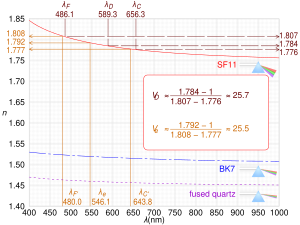Abbe number
In optics and lens design, the Abbe number, also known as the V-number or constringence of a transparent material, is an approximate measure of the material's dispersion (change of refractive index versus wavelength), with high values of V indicating low dispersion. It is named after Ernst Abbe (1840–1905), the German physicist who defined it. The term V-number should not be confused with the normalized frequency in fibers.

The Abbe number,[1] of a material is defined as
where and are the refractive indices of the material at the wavelengths of the Fraunhofer C, d, and F spectral lines (656.3 nm, 587.56 nm, and 486.1 nm respectively). This formulation only applies to the human vision. Outside this range requires the use of different spectral lines. For non-visible spectral lines the term "V-number" is more commonly used. The more general formulation defined as,
where and are the refractive indices of the material at three different wavelengths. The shortest wavelength's index is and the longest's is
Abbe numbers are used to classify glass and other optical materials in terms of their chromaticity. For example, the higher dispersion flint glasses have relatively small Abbe numbers whereas the lower dispersion crown glasses have larger Abbe numbers. Values of range from below 25 for very dense flint glasses, around 34 for polycarbonate plastics, up to 65 for common crown glasses, and 75 to 85 for some fluorite and phosphate crown glasses.

Abbe numbers are used in the design of achromatic lenses, as their reciprocal is proportional to dispersion (slope of refractive index versus wavelength) in the wavelength region where the human eye is most sensitive (see graph). For different wavelength regions, or for higher precision in characterizing a system's chromaticity (such as in the design of apochromats), the full dispersion relation (refractive index as a function of wavelength) is used.
Abbe diagram


An Abbe diagram, also called 'the glass veil', is produced by plotting the Abbe number of a material versus its refractive index Glasses can then be categorised and selected according to their positions on the diagram. This can be a letter-number code, as used in the Schott Glass catalogue, or a 6 digit glass code.
Glasses' Abbe numbers, along with their mean refractive indices, are used in the calculation of the required refractive powers of the elements of achromatic lenses in order to cancel chromatic aberration to first order. These two parameters which enter into the equations for design of achromatic doublets are exactly what is plotted on an Abbe diagram.
Due to the difficulty and inconvenience in producing sodium and hydrogen lines, alternate definitions of the Abbe number are often substituted (ISO 7944).[3] For example, rather than the standard definition given above, that uses the refractive index variation between the F and C hydrogen lines, one alternative measure using the subscript "e" for mercury's e line compared to cadmium's F′ and C′ lines is
This alternate takes the difference between cadmium's blue (C′) and red (F′) refractive indices at wavelengths 480.0 nm and 643.8 nm, relative to for mercury's e line at 546.073 nm, all of which are close by, and somewhat easier to produce than the C, F, and e lines. Other definitions can similarly be employed; the following table lists standard wavelengths at which is commonly determined, including the standard subscripts used.[4]
| λ (nm) |
Fraunhofer’s symbol |
Light source |
Color |
|---|---|---|---|
| 365.01 | i | Hg | UV-A |
| 404.66 | h | Hg | violet |
| 435.84 | g | Hg | blue |
| 479.99 | F′ | Cd | blue |
| 486.13 | F | H | blue |
| 546.07 | e | Hg | green |
| 587.56 | d | He | yellow |
| 589.3 | D | Na | yellow |
| 643.85 | C′ | Cd | red |
| 656.27 | C | H | red |
| 706.52 | r | He | red |
| 768.2 | A′ | K | IR-A |
| 852.11 | s | Cs | IR-A |
| 1013.98 | t | Hg | IR-A |
Derivation
Starting from the Lensmaker's equation we obtain the thin lens equation by dropping a small term that accounts for lens thickness, :[citation needed]
when
The change of refractive power between the two wavelengths and is given by
where and are the short and long wavelengths' refractive indexes, respectively, and below, is for the center.
The power difference can be expressed relative to the power at the center wavelength ()
by multiplying and dividing by and regrouping, get
The relative change is inversely proportional to
See also
- Abbe prism
- Abbe refractometer
- Calculation of glass properties, including Abbe number
- Glass code
- Sellmeier equation, more comprehensive and physically based modeling of dispersion
References
- ^ The Properties of Optical Glass. Schott Series on Glass and Glass Ceramics. Schott Glass. 1998. doi:10.1007/978-3-642-57769-7. ISBN 978-3-642-63349-2.
- ^ Fluegel, Alexander (2007-12-07). "Abbe number calculation of glasses". Statistical Calculation and Development of Glass Properties (glassproperties.com). Retrieved 2022-01-16.
- ^ Meister, Darryl (12 April 2010). Understanding reference wavelengths (PDF). opticampus.opti.vision (memo). Carl Zeiss Vision. Archived (PDF) from the original on 2022-10-09. Retrieved 2013-03-13.
- ^ Pye, L.D.; Frechette, V.D.; Kreidl, N.J. (1977). Borate Glasses. New York, NY: Plenum Press.


















![{\displaystyle P={\frac {1}{\ f~}}=(n-1){\Biggl [}{\frac {1}{\ R_{1}\ }}-{\frac {1}{\ R_{2}\ }}+{\frac {\ (n-1)\ d~}{\ n\ R_{1}R_{2}\ }}{\Biggr ]}\approx (n-1)\left({\frac {1}{\ R_{1}\ }}-{\frac {1}{\ R_{2}\ }}\right)\ ,}](https://wikimedia.org/enwiki/api/rest_v1/media/math/render/svg/b602cb9282f31d6b69e2264556dcfbdef4d468d7)













